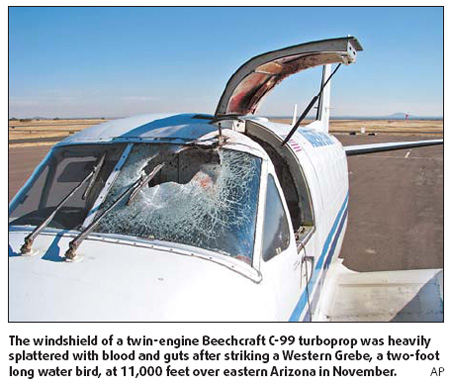Asia-Pacific
Bird-plane collisions may pass 10,000 in the US
(China Daily)
Updated: 2010-01-15 09:25
 |
Large Medium Small |
WASHINGTON: Reports of airplanes in the US hitting birds and other wildlife have soared in the year since a stricken US Airways jet landed in New York's Hudson River, and the government's tally for last year could reach or even exceed 10,000 for the first time.

Serious accidents are climbing at a faster rate than minor incidents.
There were at least 57 cases in the first seven months of 2009 that caused serious damage and three in which planes and a corporate helicopter were destroyed by birds, according to an analysis by The Associated Press of the latest government figures available. At least eight people died, and six more were hurt.
The destroyed planes include the Airbus A320 that, with 155 passengers and crew, went into the Hudson a year ago this week after hitting a flock of Canada geese. No lives were lost in that dramatic river landing.
And there is no shortage of frightening reports of knocked-out engines and emergency landings.
Why the increase in bird-strike reports? Airports and airlines have become more diligent about reporting, said Mike Beiger, national coordinator for the airport wildlife hazards program at the Agriculture Department. But experts also say populations of large birds like Canada geese that can knock out engines on passenger jets have increased.
"Birds and planes are fighting for airspace, and it is getting increasingly crowded," said Richard Dolbeer, an expert on bird-plane collisions who is advising the Federal Aviation Administration and the Agriculture Department.
The problem is not new: Environmental activists in Texas forced urban planners in the 1990s to abandon plans to build a major new airport for Houston on the city's west side near Katy, because the site was in the middle of flyways for millions of migratory birds.
The surge in reports for 2009 - expected to be as much as 40 percent higher once the final accounting is in - comes in spite of government concerns that disclosing details about such strikes would discourage reports by airports and airlines out of worries about lost business. The previous high was 7,507 strikes in 2007. The government's estimate of as many as 10,000 for 2009 would represent about 27 strikes every day.
"Going public doesn't appear to have harmed it, and every indicator I have is we have an increased industry awareness on the importance of reporting," said Kate Lang, FAA acting associate administrator for airports.
Not all airports have been diligent. Teterboro Airport in New Jersey, for example, showed 46 strikes during the first seven months of 2008 but only 12 for the same period in 2009. When the AP asked about the decline, the airport said there were 28 strikes - not 12 - during that period in 2009 but the airport had neglected to report more than half of them.
Dolbeer, the government's bird-strike expert, said a spate of serious collisions that took place kilometers away from airports was especially troubling.
On Nov 4 over eastern Arizona, for instance, air cargo pilot Roger Wutke had just begun a descent from 11,000 feet (3,350 meters) in his twin-engine Beechcraft turboprop when a western grebe - a two-foot-long (0.61-meter) water bird - crashed through his windshield. The bird hit Wutke, knocking off his glasses, breaking his radio headset and splattering him in blood.
Unable to see out much of the shattered left windshield and unable to hear air traffic controllers, Wutke still managed to land the plane safely.
"I don't know how I did it," Wutke, 26, said in an interview. "It was pretty rough."
Some airports are replacing shrubbery that attracts birds and insects that other birds eat. In some cases, airports bring in predatory hawks to chase away flocks of smaller birds.
A government-industry committee that develops solutions to aviation safety problems recently agreed to make bird strikes one of its key research issues, Lang said.
AP










